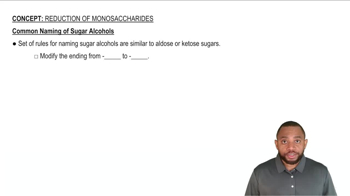Textbook Question
Explain the difference between an oligosaccharide and a polysaccharide.
20
views
 Verified step by step guidance
Verified step by step guidance



Explain the difference between an oligosaccharide and a polysaccharide.
Explain the difference between an aldose and a ketose.
Describe the properties of soluble fiber.
How are the following pairs of carbohydrates, shown in a Fischer projection, related to each other? Are they structural isomers, enantiomers, diastereomers, or epimers?
(a) <IMAGE>
Draw the Fischer projection of the C3 epimer of d-glucose. Compare your structure with those in Table 6.1 and give the name of this compound.
Draw the Fischer projection of the product of reduction reaction of d-galactose at C1